The Grey Goshawk (Accipiter novaehollandiae) emerges as a captivating and enigmatic figure in the avian kingdom, donning a mantle of elegance and predatory prowess.
As a bird of prey belonging to the Accipitridae family, this species, characterized by its striking grey plumage, commands attention in the Australian and surrounding Oceania regions.
The Grey Goshawk’s ethereal appearance, accentuated by its piercing yellow eyes, presents a visual spectacle against the backdrop of diverse habitats, from dense forests to open woodlands.
Renowned for its agile flight and keen hunting instincts, this raptor navigates the intricate tapestry of its ecosystem, embodying both the beauty and ferocity inherent in the realm of avian predators.
Delving into the Grey Goshawk’s story unveils a narrative of adaptation and survival, making it a subject of fascination for bird enthusiasts and ornithologists alike.
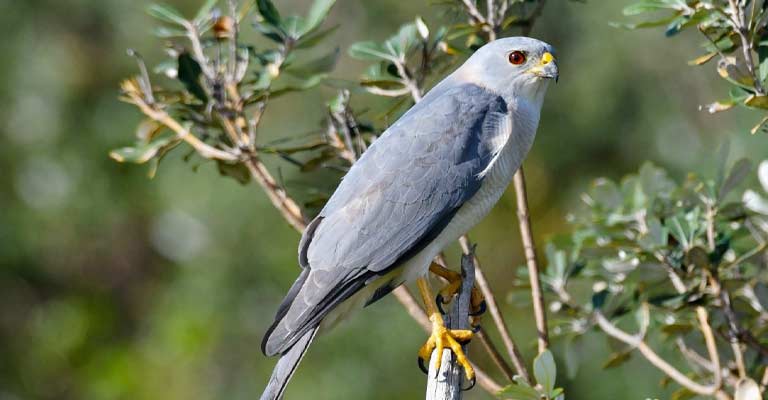
Identifying Characteristics of Grey Goshawk
Identifying the Grey Goshawk (Accipiter novaehollandiae) involves keen observation of distinct features that set this raptor apart within the avian kingdom.
Here are eight key characteristics to aid in the identification of the Grey Goshawk:
Plumage Variation
The Grey Goshawk exhibits a range of plumage variations, from light grey to dark slate. This subtle spectrum allows for adaptation to diverse environments, blending seamlessly with the surrounding vegetation.
Yellow Eyes
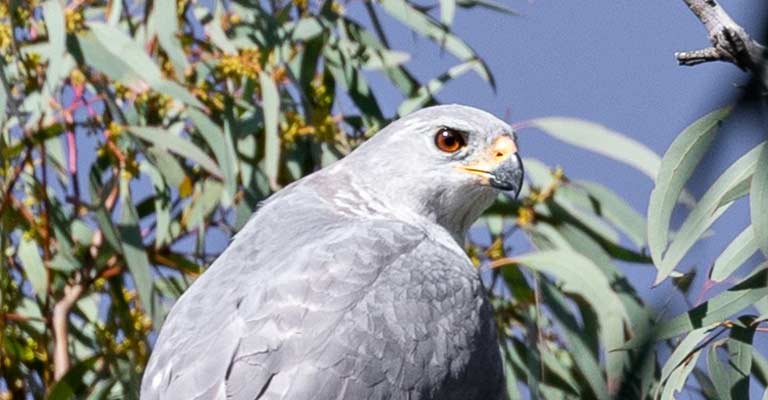
One of the most striking features is the intense yellow coloration of the eyes. The vividness of the eyes adds a contrasting element to the overall grey plumage, creating a regal and captivating appearance.
Size and Build
Classified as a medium-sized raptor, the Grey Goshawk typically measures between 45 to 55 centimeters in length. Its robust and compact build, coupled with relatively short wings, contributes to its agility during flight.
Distinctive Head Crest
While not as prominent as some other goshawk species, the Grey Goshawk does possess a subtle crest on its head. This feature may be raised during moments of alertness, providing an additional identifying characteristic.
Facial Mask
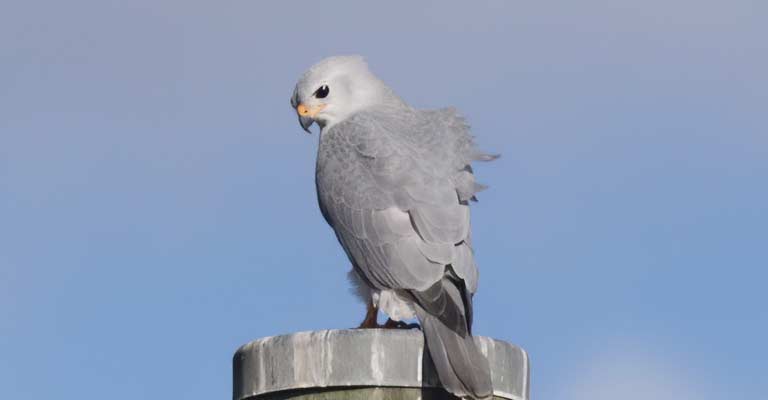
Grey Goshawks often display a dark facial mask, characterized by darker markings around the eyes. This mask accentuates their predatory gaze and contributes to their overall distinctive appearance.
Tail Bands
The tail of the Grey Goshawk is finely banded with dark markings. These bands, visible during flight or when the bird is perched, aid in distinguishing it from other raptors.
Juvenile Plumage
Juvenile Grey Goshawks have a different appearance with brown plumage, and they may lack the grey tones seen in adults. This mottled appearance provides a clear distinction during the early stages of life.
Flight Pattern
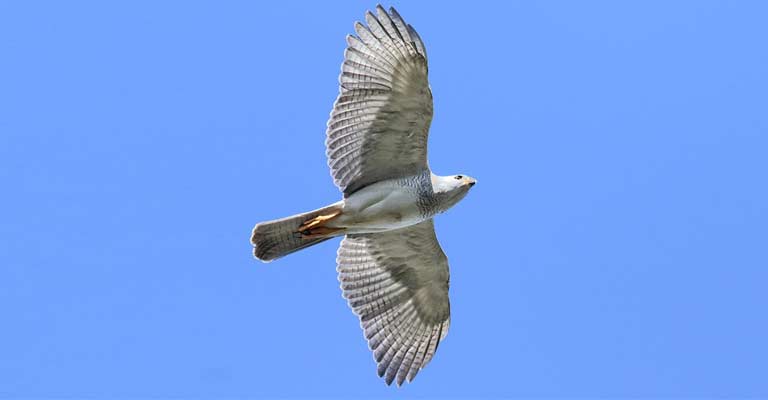
In flight, the Grey Goshawk displays a characteristic pattern with deliberate wing beats and short glides. Its flight is often described as direct and purposeful, emphasizing its predatory nature.
Identifying the Grey Goshawk involves a holistic approach, considering the interplay of subtle plumage variations, facial features, size, and flight patterns.
This raptor’s adaptability to diverse habitats and its ability to seamlessly blend into the environment make it a captivating subject for bird enthusiasts and researchers alike.
As observers delve into the intricacies of its identifying characteristics, the Grey Goshawk emerges as a testament to the intricate beauty and evolutionary adaptability of avian life.
Taxonomy of Grey Goshawk
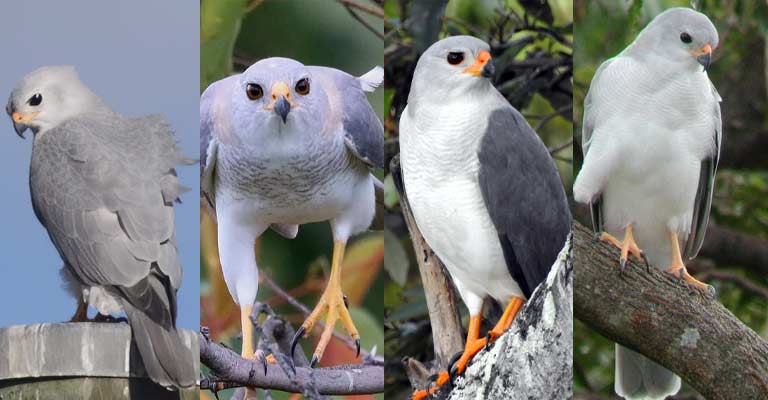
Here is a table outlining the taxonomical details of the Brown Goshawk (Accipiter fasciatus):
| Taxonomic Level | Classification |
| Domain | Eukaryota |
| Kingdom | Animalia |
| Phylum | Chordata |
| Class | Aves |
| Order | Accipitriformes |
| Family | Accipitridae |
| Genus | Accipiter |
| Species | A. novaehollandiae |
The Grey Goshawk (Accipiter novaehollandiae) belongs to the Animalia kingdom, Chordata phylum, Aves class, and Accipitriformes order. It is part of the Accipitridae family, known for birds of prey, and the Accipiter genus.
The species name, novaehollandiae, reflects its association with New Holland, a historical name for Australia.
This raptor’s taxonomy underscores its position within the intricate web of avian biodiversity, highlighting its specific role in the ecosystems of Australia and Oceania.
Grey Goshawk Life History
The Grey Goshawk (Accipiter novaehollandiae) unfolds a captivating life history, seamlessly blending elegance and predatory prowess.
Native to Australia and neighboring Oceania regions, this bird of prey navigates diverse landscapes, embodying a balance between its hunting instincts and ecological adaptations.
Food
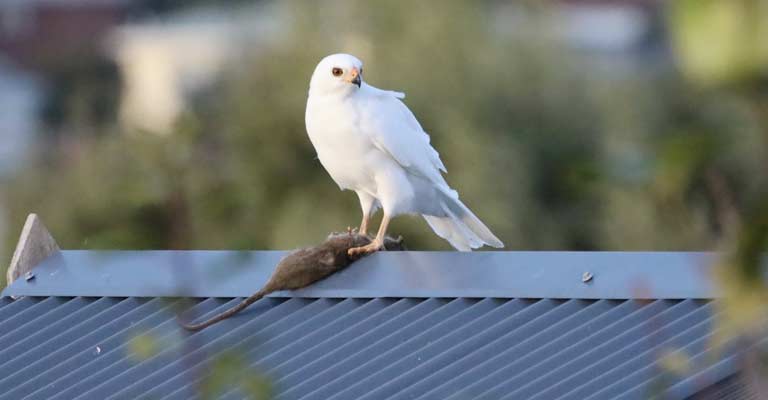
The Grey Goshawk’s diet is a diverse palette, featuring small mammals, birds, and occasionally reptiles. With sharp talons and keen vision, it executes precise aerial strikes, showcasing its prowess as a skilled predator.
Habitat
Adaptable to various environments, Grey Goshawks inhabit a range of habitats, from dense forests to open woodlands. Their adaptability highlights their versatility in navigating both natural ecosystems and human-altered landscapes.
Range Map
A visual representation of their distribution reveals a widespread presence across Australia and nearby islands.
The range map illustrates the Grey Goshawk’s adaptability to varied geographical and environmental conditions within its habitat.
Breeding
Breeding rituals involve the construction of nests with sticks, strategically placed high in the canopy for concealment.
The female lays a clutch of 2 to 3 eggs, and both parents actively participate in incubation and raising the nestlings.
Diseases
While resilient, Grey Goshawks may face health challenges, including diseases that affect their overall well-being. Monitoring for signs of illness is crucial for early intervention and effective conservation strategies.
Treatment
Addressing diseases involves a comprehensive approach, combining veterinary care, habitat preservation, and mitigating potential threats.
Collaborative efforts between wildlife experts and conservationists play a vital role in ensuring the health of Grey Goshawk populations.
Conservation
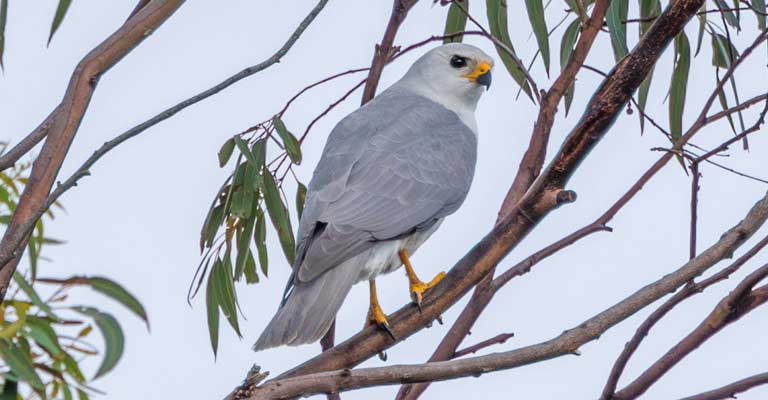
Grey Goshawks, though adaptable, confront conservation challenges such as habitat loss and potential threats.
Conservation initiatives, including habitat preservation and public awareness, are essential to sustain their populations and maintain ecological balance.
In essence, the Grey Goshawk’s life history is a narrative of adaptability, from its hunting strategies and nesting behaviors to the challenges it faces in an ever-changing environment.
Understanding and appreciating these facets contribute to the broader discourse of avian biodiversity and the delicate interplay between predators and their ecosystems.
Nesting Habit of Grey Goshawk
The nesting habits of the Grey Goshawk (Accipiter novaehollandiae) are a testament to its adaptive nature and meticulous approach to reproduction.
Typically selecting well-concealed locations within the canopy of trees, the Grey Goshawk constructs nests using sticks, creating sturdy platforms that provide a secure environment for its eggs and nestlings.
The choice of concealed sites offers protection against potential predators and minimizes disturbances during the vulnerable stages of nesting.
The female Grey Goshawk lays a clutch of 2 to 3 eggs, each characterized by an oval shape with a pale background adorned by irregular reddish-brown markings.
Both male and female play active roles in incubation, taking turns to keep the eggs warm for an approximate period of 35 days. This cooperative effort extends to the nestling period, which lasts about 5 to 6 weeks.
Let’s learn more about the nesting habit of this bird from the below table:
| Nesting Details | Facts |
| Clutch Size | Typically 2 to 3 eggs |
| Number of Broods | Usually 1 to 2 broods per breeding season |
| Egg Length | Approximately 5.0 to 5.5 centimeters |
| Egg Width | Around 3.8 to 4.2 centimeters |
| Incubation Period | Approximately 35 days |
| Nestling Period | About 5 to 6 weeks |
| Egg Description | Oval-shaped, with a pale background and irregular reddish-brown markings. |
| Nest Type | Constructed with sticks, often placed in the canopy of trees for concealment. |
| Parental Involvement | Both males and females participate in the incubation and feeding of the nestlings. |
10 Fun Facts About Grey Goshawk
The Grey Goshawk (Accipiter novaehollandiae) reveals a myriad of fascinating attributes that contribute to its charm within the avian world. Here are 10 fun facts about this enigmatic bird of prey:
- Subtle Color Variations: Despite its name, the Grey Goshawk displays a range of color variations, from light grey to dark slate, providing a captivating spectrum of plumage.
- Yellow Iris Intensity: The Grey Goshawk is renowned for its striking yellow eyes, adding a vivid contrast to its grey feathers and contributing to its regal appearance.
- Masterful Mimicry: This raptor exhibits exceptional mimicry skills, imitating the calls of other birds to lure them closer. This deceptive strategy aids in surprise attacks during hunting.
- Urban Residents: Grey Goshawks demonstrate adaptability by thriving in urban environments. They are occasionally observed in city parks and suburban areas, showcasing a remarkable ability to coexist with human landscapes.
- Cryptic Nesting Sites: When constructing nests, Grey Goshawks strategically choose concealed locations high in the canopy, minimizing the risk of predation and ensuring the safety of their eggs and nestlings.
- High-Aerial Displays: During courtship displays, these birds engage in high aerial acrobatics, demonstrating their agility and strengthening pair bonds through synchronized flight patterns.
- Monogamous Pairs: Grey Goshawks are known for forming monogamous breeding pairs, emphasizing the importance of strong and lasting bonds between mates during the reproductive season.
- Versatile Diet: While primarily carnivorous, Grey Goshawks exhibit a diverse diet, preying on small mammals, birds, and reptiles. This adaptability allows them to thrive in various ecosystems.
- Frequent Vocalizations: Communication is crucial for these raptors. They use a variety of vocalizations, including sharp calls and whistles, for territory establishment, courtship, and maintaining communication within pairs.
- Conservation Challenges: Despite their adaptability, Grey Goshawks face conservation challenges due to habitat loss and potential threats. Conservation efforts are essential to safeguard these charismatic birds and maintain healthy ecosystems.
The Grey Goshawk’s fun facts unveil a story of versatility, intelligence, and resilience, making it a species that captivates both bird enthusiasts and casual observers alike in the vast landscapes of Australia and Oceania.
Wrapping Up
As monogamous pairs engage in high aerial displays and construct cryptic nests, the Grey Goshawk unfolds a tale of familial dedication and strategic nesting practices.
Yet, amid the marvels, conservation challenges loom, urging us to address habitat loss and potential threats.
Preserving the Grey Goshawk’s place in the skies becomes not just a testament to its biological significance but a commitment to sustaining the delicate balance of biodiversity in the regions it calls home.
Ultimately, this enigmatic raptor beckons us to delve deeper into the complexities of avian life, fostering a shared responsibility for its well-being in the ever-changing landscapes it inhabits.
